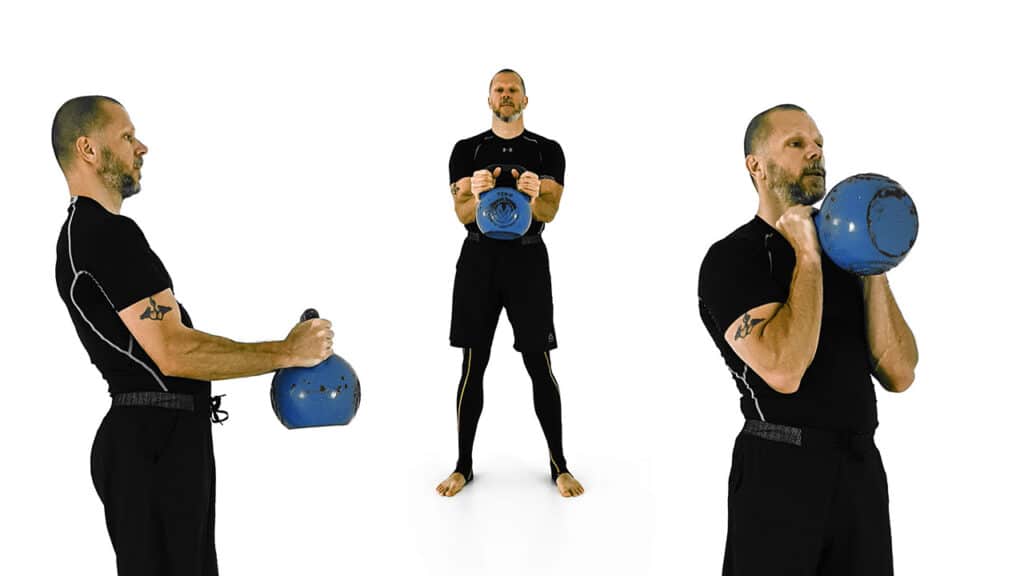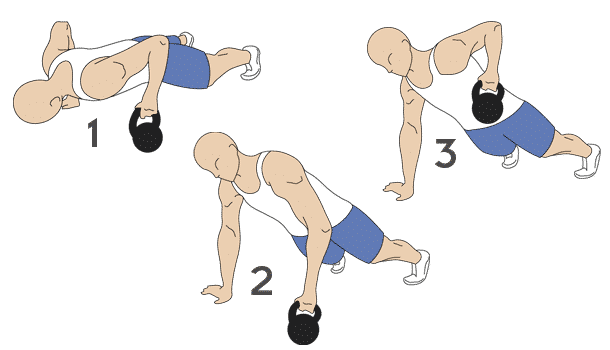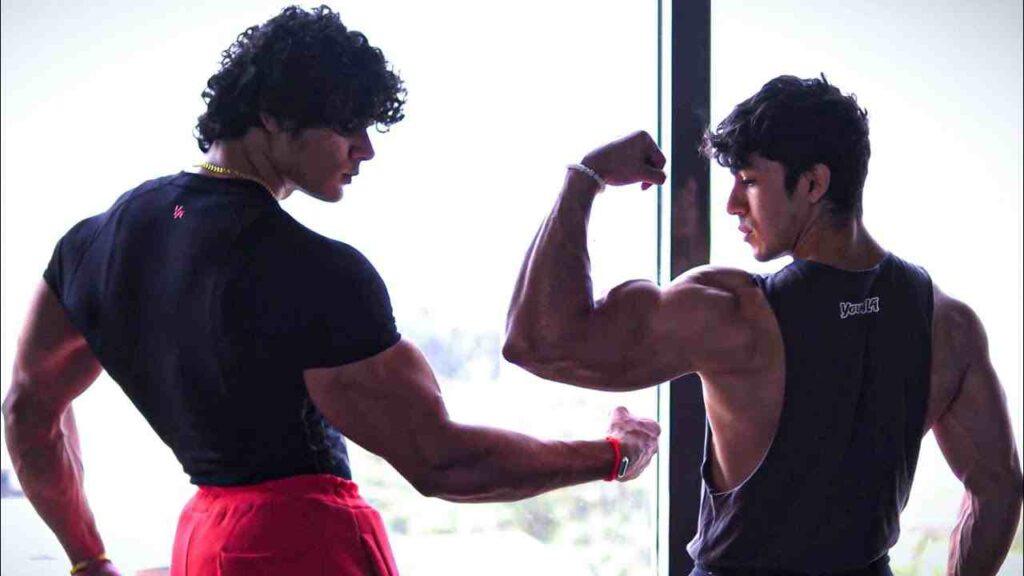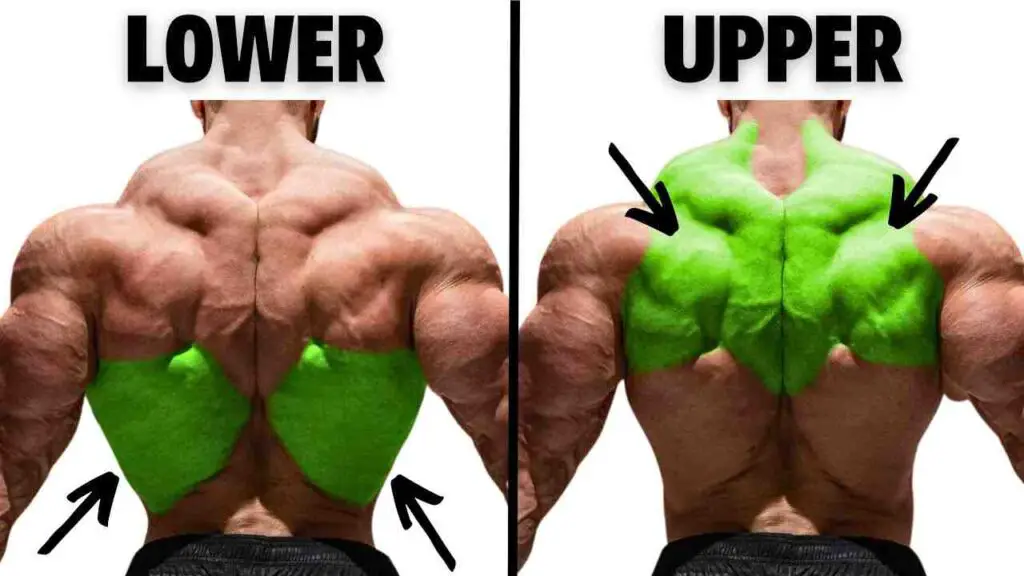Introduction
Tired of the same old arm exercises that seem to bring slow progress? It’s time to spice up your arm workout routine and unlock the potential of your biceps and triceps with kettlebells. Kettlebell arm workouts offer an innovative and highly effective approach to arm sculpting that can take your fitness journey to the next level.
SHOP FOR THE KETTLEBELL SET ON AMAZON
In this comprehensive guide, we’ll explore the world of kettlebell arm workouts, including a range of exercises, expert tips, and Safety Precautions. By the end of this article, you’ll be armed with the knowledge you need to attain those well-defined, powerful arms you’ve always dreamed of.
Why Kettlebells for Arm Workouts?
When it comes to arm workouts, kettlebells offer a unique and effective approach that sets them apart from traditional dumbbells. Here’s why you should consider incorporating kettlebells into your arm workout routine:
The benefits of using kettlebells for arm workouts
Kettlebells are not just another piece of gym equipment; they bring several advantages to the table, especially for arm-focused workouts:
- Versatility: Kettlebells can be used for a wide range of exercises, making them a versatile tool for your arm workout routine. From curls to presses and swings, you can target different arm muscles with a single piece of equipment.
- Cardiovascular benefits: Kettlebell exercises often involve dynamic movements that get your heart rate up. This means you not only build muscle but also improve your cardiovascular fitness simultaneously, which is a significant advantage over traditional arm workouts.
- Functional strength: Kettlebell exercises mimic real-life movements and activities, enhancing your functional strength. This means your arms won’t just look great; they’ll be more capable in day-to-day tasks.
- Engagement of stabilizing muscles: Kettlebells, with their unique shape and off-center mass, challenge your grip, core, and stabilizing muscles more than traditional dumbbells. This leads to more comprehensive muscle engagement and a stronger, well-rounded physique.
- Time efficiency: Kettlebell workouts are often more time-efficient because they engage multiple muscle groups simultaneously. This can be particularly beneficial for those with busy schedules.
How kettlebells engage more muscles compared to traditional dumbbells
Kettlebells encourage full-body engagement, even during arm-specific exercises. Here’s how they differ from traditional dumbbells in this aspect:
- Offset center of mass: The uneven distribution of weight in a kettlebell requires more effort to control and stabilize, engaging your core and supporting muscles. With traditional dumbbells, the weight is evenly distributed, offering less of a stability challenge.
- Fluid, dynamic movements: Many kettlebell exercises involve dynamic, fluid movements, such as swings and snatches. These movements force you to use multiple muscle groups simultaneously, from your arms to your legs and back, promoting an all-encompassing workout experience.
- Increased range of motion: Kettlebell exercises often encourage a greater range of motion, which allows for more extended muscle engagement. Traditional dumbbell exercises can sometimes limit your range of motion, which may not target your muscles as effectively.
SHOP FOR THE ADJUSTABLE DUMBBELL SET ON AMAZON
In summary, kettlebells offer a more versatile, efficient, and engaging way to work your arm muscles. Their unique design and exercise routines stimulate more muscle groups, improve cardiovascular health, and provide functional strength that extends beyond the gym.
Kettlebell Bicep Workout
Your biceps are one of the key components of well-defined arms. With kettlebells, you can effectively target and strengthen these muscles. Here are six kettlebell bicep exercises to get you started:
1. Kettlebell Bicep Curls

Kettlebell bicep curls are a powerful exercise for building sleeve-busting biceps. This exercise targets your bicep directly, helping you achieve that desirable peak.
How to Perform:
- Stand with your feet hip-width apart, holding a kettlebell in each hand with your arms fully extended.
- Keep your elbows close to your body and curl the kettlebells towards your chest while contracting your biceps.
- Slowly lower the kettlebells back to the starting position, maintaining control throughout the movement.
- Perform 3 sets of 10-12 repetitions.
Tips:
- Avoid swinging your body or using momentum; focus on a controlled movement.
- Gradually increase the weight as your strength improves to keep challenging your muscles.
2. Kettlebell Hammer Curls

Kettlebell hammer curls provide a unique twist on traditional bicep curls. This exercise not only targets your biceps but also works your forearms for well-rounded arm development.
How to Perform:
- Stand with your feet shoulder-width apart, holding a kettlebell in each hand with a neutral grip (palms facing your body).
- Keep your back straight, and your core engaged. Lift the kettlebells toward your chest while keeping your elbows close to your body.
- Slowly lower the kettlebell back to the starting position.
- Aim for 3 sets of 10-12 repetitions.
Tips:
- Maintain a steady, controlled motion throughout the exercise.
- Focus on the squeeze at the top of the movement to maximize bicep engagement.
- Don’t rush; prioritize proper form over heavy weights to avoid strain.
3. Kettlebell Concentration Curls
Concentration curls with a kettlebell are excellent for isolating the biceps. This exercise helps you improve the peak of your biceps.
How to Perform:
- Sit on a bench or a chair with your legs spread apart.
- Hold a kettlebell with one hand, and let it hang between your legs, with your arm fully extended.
- Keeping your upper arm against your inner thigh, curl the kettlebell towards your chest.
- Squeeze your biceps at the top of the movement.
- Lower the kettlebell back to the starting position.
- Complete 3 sets of 10-12 reps on each arm.
Tips:
- Focus on the mind-muscle connection and feel the bicep contraction.
- Use a controlled, deliberate motion without swinging.
4. Kettlebell Zottman Curls
Zottman curls are an advanced kettlebell bicep exercise that targets both the biceps and the forearms.
How to Perform:
- Stand with your feet shoulder-width apart, holding a kettlebell in each hand with palms facing up.
- Curl the kettlebells towards your chest as you would in a regular bicep curl.
- At the top of the movement, rotate your wrists so that your palms face down (pronated grip).
- Slowly lower the kettlebells while maintaining the pronated grip.
- Rotate your wrists back to the palms-up position as you complete the repetition.
- Perform 3 sets of 10-12 reps.
Tips:
- The rotation is what makes this exercise effective, so focus on it for maximum benefits.
- Use a controlled motion throughout the exercise.
5. Kettlebell Preacher Curls
Preacher curls with a kettlebell mimic the preacher bench at the gym, providing excellent isolation for the biceps.
How to Perform:
- Position a bench at a 45-degree angle. Sit on the bench and rest your upper arms on the inclined surface.
- Hold a kettlebell in one hand with your arm fully extended over the bench.
- Curl the kettlebell towards your chest, keeping your upper arm firmly against the bench.
- Squeeze your biceps at the top of the movement.
- Lower the kettlebell back to the starting position.
- Complete 3 sets of 10-12 reps on each arm.
Tips:
- Ensure your upper arm remains stable on the bench throughout the exercise.
- Use a weight that challenges you without sacrificing proper form.
6. Kettlebell 21s
Kettlebell 21s are a variation of the classic bicep curls. This exercise adds an extra challenge to your bicep workout.
How to Perform:
- Stand with your feet shoulder-width apart, holding a kettlebell in each hand.
- Perform 7 partial reps, curling the kettlebells from the bottom to the halfway point.
- Then, perform 7 partial reps from the halfway point to the top.
- Finish with 7 full-range bicep curls.
- Complete 3 sets of 21s.
Tips:
- Maintain a steady tempo throughout the 21 reps.
- Start with a manageable weight, as this exercise can be quite intense.
SHOP FOR THE WORKOUT SUPPLEMENT ON AMAZON
Including these exercises in your kettlebell bicep workout routine will help you achieve stronger, more defined biceps. Remember to start with an appropriate weight and gradually increase the load as you progress. Proper form and consistency are key to successful kettlebell bicep workouts.
Kettlebell Tricep Workout
Strong triceps are vital for achieving well-defined arms. This kettlebell tricep workout focuses on building strength and toning those often underappreciated muscles. Here are six kettlebell tricep exercises to get you started:
1. Kettlebell Tricep Extensions
Kettlebell tricep extensions, also known as “skull crushers,” target the triceps by extending your arm at the elbow. This exercise provides an excellent stretch and contraction of the triceps.
How to Perform:
- Lie on your back on a bench or the floor.
- Hold a kettlebell with both hands above your chest, arms extended.
- Bend your elbows to lower the kettlebell towards your forehead, keeping your upper arms stationary.
- Extend your arms to the starting position, contracting your triceps.
- Perform 3 sets of 12-15 repetitions.
Tips:
- Start with a lighter kettlebell to ensure proper form.
- Keep your core engaged and maintain a stable wrist position.
- Use a spotter or choose a weight you can safely control.
2. Kettlebell Tricep Dips

Kettlebell tricep dips are an effective bodyweight exercise that can be intensified with the addition of kettlebells. This exercise targets the triceps, shoulders, and chest.
How to Perform:
- Position two kettlebells on the floor, handles parallel and within shoulder-width apart.
- Sit on the edge of a bench or a stable surface with your hands gripping the kettlebell handles beside your hips.
- Slide off the bench with your legs extended and feet on the floor.
- Lower your body by bending your elbows until they reach a 90-degree angle.
- Push back up to the starting position, extending your arms.
- Perform 3 sets of 10-12 repetitions.
Tips:
- Keep your back close to the bench to maintain proper form.
- Avoid locking your elbows at the top to keep tension on the triceps.
- Ensure the kettlebells are stable and won’t shift during the exercise.
3. Kettlebell Skull Crushers
Kettlebell skull crushers are a variation of tricep extensions that provide an intense contraction for your triceps.
How to Perform:
- Lie on your back on a bench with a kettlebell in each hand, arms extended above your chest.
- Bend your elbows to lower the kettlebells towards your temples while keeping your upper arms stationary.
- Extend your arms back to the starting position, focusing on your triceps.
- Perform 3 sets of 10-12 repetitions.
Tips:
- Start with a manageable weight to ensure proper control.
- Maintain a stable wrist position and engage your core.
4. Kettlebell Kickbacks
Kettlebell kickbacks are an effective exercise for isolating the triceps and developing the “horseshoe” shape of the muscle.
How to Perform:
- Hold a kettlebell in your right hand, stand with your feet hip-width apart, and bend your knees slightly.
- Bend your torso forward at the hips, keeping your back straight.
- Extend your right arm straight behind you, contracting your triceps.
- Return to the starting position and complete 3 sets of 12-15 repetitions on each arm.
Tips:
- Keep your upper arm parallel to the ground throughout the movement.
- Focus on the mind-muscle connection to maximize tricep engagement.
5. Kettlebell Overhead Tricep Extensions

Kettlebell overhead tricep extensions target the long head of the triceps and help increase overall arm strength.
How to Perform:
- Stand with your feet shoulder-width apart, holding a kettlebell with both hands by the handle.
- Lift the kettlebell overhead, fully extending your arms.
- Bend your elbows to lower the kettlebell behind your head, then extend your arms to lift it back up.
- Perform 3 sets of 10-12 repetitions.
Tips:
- Use a comfortable weight to avoid straining your shoulders.
- Maintain a strong core and focus on the extension of the triceps.
6. Kettlebell Tricep Push-Ups

Kettlebell tricep push-ups are a challenging variation of traditional push-ups that work the triceps effectively.
How to Perform:
- Place two kettlebells on the floor, handles parallel, and shoulder-width apart.
- Assume a push-up position with your hands on the kettlebell handles.
- Perform push-ups, keeping your elbows close to your body to target the triceps.
- Complete 3 sets of 10-12 repetitions.
Tips:
- Ensure stable kettlebells and a straight body position during the exercise.
- Modify the intensity by adjusting the kettlebell height or performing knee push-ups if needed.
Incorporate these kettlebell tricep exercises into your arm workout routine to effectively target and strengthen your triceps. Remember to use proper form and gradually increase the weight to challenge your muscles and achieve the desired results.
Combining Bicep and Tricep Workouts
To achieve a balanced and complete arm workout, it’s crucial to incorporate exercises that target both the biceps and triceps. By doing so, you’ll not only sculpt your arms but also maintain proper muscle symmetry. Here’s how you can create an effective routine by combining bicep and tricep workouts:
1. Supersets: Supersets involve performing two exercises back-to-back, one for biceps and one for triceps, without resting in between. This method keeps your heart rate elevated, increases the intensity, and saves time.
Example Superset:
- Exercise 1: Kettlebell Bicep Curls
- Exercise 2: Kettlebell Tricep Dips
- Perform 3 sets of 12-15 reps for each exercise in succession, resting for 60-90 seconds between supersets.
2. Circuit Training: Circuit training combines multiple exercises targeting different muscle groups. You can create a circuit that includes bicep and tricep exercises along with other compound movements for a full-body workout.
Example Circuit:
- Exercise 1: Kettlebell Bicep Curls
- Exercise 2: Kettlebell Tricep Extensions
- Exercise 3: Kettlebell Squats
- Perform each exercise for 45 seconds, with a 15-second rest between exercises. Complete 3-4 rounds.
3. Alternating Sets: Alternating sets involve performing a set of bicep exercises followed by a set of tricep exercises, alternating between the two muscle groups. This approach allows for adequate rest between exercises while keeping the workout efficient.
Example Alternating Set:
- Set 1: Kettlebell Bicep Concentration Curls
- Set 2: Kettlebell Tricep Skull Crushers
- Perform 3 sets of each exercise, resting for 60-90 seconds between sets.
4. Isolation and Compound Movements: In your combined arm workouts, include both isolation exercises (targeting a single muscle group) and compound exercises (working multiple muscle groups). This diversity ensures a comprehensive approach to arm development.
- Isolation Exercise (Biceps): Kettlebell Concentration Curls
- Compound Exercise (Triceps): Kettlebell Tricep Dips
By varying your workouts and incorporating these strategies, you’ll prevent plateaus, stimulate muscle growth, and achieve balanced arm development. Remember to maintain proper form and progressively increase the weight or intensity of your exercises to continue challenging your muscles.
Tips for Maximizing Your Kettlebell Arm Workout
- Breathing Techniques: Proper breathing is crucial during your kettlebell arm workout. Exhale during the concentric (lifting) phase of the exercise and inhale during the eccentric (lowering) phase. This helps stabilize your core and enhance your strength and control.
- The Importance of Progressive Overload: To continue seeing results, gradually increase the weight of your kettlebell or the number of repetitions. This progressive overload ensures that your muscles continue to adapt and grow over time.
- Staying Consistent and Tracking Progress: Consistency is key to success in any workout routine. Make a schedule and stick to it. Keep a workout journal to track your progress, noting the weights and reps for each exercise. This allows you to monitor your growth and make necessary adjustments.
- Vary Your Repetition Ranges: Change the repetition ranges in your workouts. Using lower reps with heavier kettlebells builds strength, while higher reps with lighter kettlebells improve muscular endurance. A mix of both can provide a balanced approach.
- Incorporate Isometric Holds: Add isometric holds to your routine. For example, pause at the top of a bicep curl for a few seconds before lowering the kettlebell. Isometric contractions can increase muscle tension and stimulate growth.
- Use Different Grips: Experiment with different grips when holding the kettlebell. A neutral grip, overhand grip, or underhand grip can target your arm muscles from different angles, preventing plateaus and promoting balanced development.
SHOP FOR THE FITNESS TRACKER ON AMAZON
By following these tips, you’ll not only maximize the effectiveness of your kettlebell arm workout but also reduce the risk of injury and ensure steady progress towards your fitness goals.
FAQs
Q. 1. What weight should I start with for kettlebell arm workouts?
Ans. It’s important to start with a weight that you can handle comfortably while maintaining proper form. For beginners, a kettlebell in the range of 5 to 15 pounds (2.3 to 6.8 kilograms) is a good starting point. As you progress, you can gradually increase the weight.
Q. 2. How often should I do kettlebell arm workouts?
Ans. The frequency of your kettlebell arm workouts depends on your fitness level and goals. For most individuals, working your arms with kettlebells 2 to 3 times a week is sufficient. Ensure you allow adequate rest between workouts to promote muscle recovery and growth.
Q. 3. Can women do kettlebell arm workouts without bulking up?
Ans. Yes, women can incorporate kettlebell arm workouts into their fitness routine without worrying about bulking up. Kettlebells can help tone and define your arms, but achieving a bulky appearance typically requires a specific diet and intense training that many women do not pursue. Kettlebells are an excellent tool for achieving lean and strong arms.
Q. 4. Should I consult a trainer before starting kettlebell arm exercises?
Ans. If you’re new to kettlebell training or have any underlying medical conditions, consulting a fitness professional or personal trainer is a wise choice. They can help you learn proper form, tailor workouts to your specific needs, and prevent injuries. Proper guidance can significantly enhance the effectiveness of your kettlebell arm workouts.
Conclusion
In conclusion, a well-structured kettlebell arm workout can be a game-changer for achieving stronger and more defined biceps and triceps. By incorporating the right exercises, maintaining proper form, and following essential tips, you can make the most of your kettlebell arm training.
Kettlebells offer a unique and efficient way to engage your arm muscles, and with consistent effort, you can achieve impressive results. Whether you’re a beginner or an experienced fitness enthusiast, kettlebell arm workouts can be tailored to your needs and goals.

Good day, and welcome to Fitthour. My name is Shubham Vijay, and I am a certified personal trainer and nutrition coach with 6 years of experience in the fitness industry. At Fitthour, we specialize in types of training, such as strength training, cardio, or HIIT, and our mission is to help clients achieve their fitness goals and improve their overall health.




